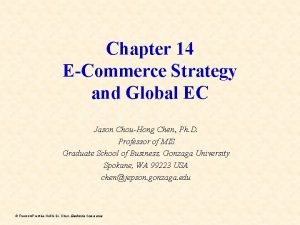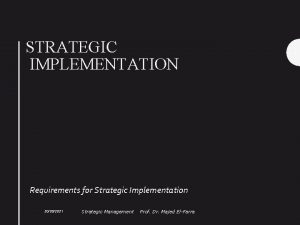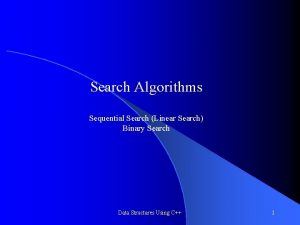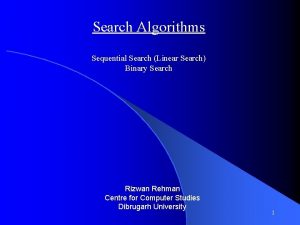Strategic Implementation Administration and Organization In Search of
















- Slides: 16

Strategic Implementation, Administration and Organization In Search of Efficiency and Superior Execution

Implementation Is Strategy n Distinctive performance is almost entirely a function of deeply engrained repertoires – not one thing a 1000% better but a 1000 things 1% better – organizations consist of many things -- the most critical are its inherent skills or distinctive competencies – distinctive skills -- “thousand little things” are the real source of “unassailable” barriers to imitation

THE CRITICAL COMPONENTS OF STRATEGY IMPLEMENTATION n n Innovative, dedicated, motivated people Creative empowering leadership Organizational structures the match competitive strategies, efficiently Organizational controls and incentives that efficiently focus people on strategic goals and objectives n n appropriate administrative procedures and policies Organizational arrangements that efficiently “govern” the critical activities. n n efficient organizational boundaries internalized vs out-sourced (in some non-hierarchial organizational arrangement)

ORGANIZATIONAL STRUCTURE n n Structure follows strategy; but then strategy must follow structure Objective of organizational structure is to balance: n n n the economic advantages of specialization, with the problems and costs of coordination and motivation, i. e. bureaucratic costs Bureaucratic costs arise from: n n supervisory monitoring motivation problems coordination activities opportunism and information distortions

GENERIC ORGANIZATIONAL STRUCTURAL FORMS n n Three Generic Organizational Structures – U-Forms (Unitary or Functional Structures) – M-Forms (Multidivisional Structures) – H-Forms (Holding or Conglomerate Structures) Hybrid Organizational Structures – Matrix Structures – Team-based Structures

U-FORMS n n Functional (or U-Form) Structures group or “chunk” on the basis of their common expertise/experience or because they use the same resources or focus on the same activities Advantages: n n increased specialization economies of scale in monitoring critical decision-making is centralized in one “peak” person Disadvantages: n n cannot handle the complexity of multiple activities well subgoal pursuit problems can become acute absence of objective measures of performance operational concerns can divert attention from strategic/competitive/entrepreneurial issues

M-FORMS n n n A Multi-divisional structure is designed to manage diversification while controlling bureaucratic costs and control-loss problems M-Forms decentralizes operating decision-making to the business unit/division level where all necessary competitive and operational decisions are made. Strategic decision-making responsibility is retained at the headquarters level. The HQ also monitors division’s performance by using both objective market/output measures and subjective performance measures.

M-FORMS n Advantages: n n n uses objective market/output performance measures, bureaucratic controls, and clan/cultural controls encourages the exploiting of economies of scope across divisions frees corporate to focus on strategic concerns Facilitates diversification and growth Disadvantages: n n n Introduces additional levels of hierarchy Opportunism and information distortion problems Myopic focus Divisions may compete at the expense of cooperating Transfer pricing battles

Three Types of M-form and Their Optimal Use Cooperative Form -- Related. Constrained n SBU Form -- Related-Linked n Competitive Form -- Unrelated n

H-FORMS n Holding or Conglomerate structures seek to exploit the advantages of internal capital markets

ORGANIZATIONAL GOVERNANCE n n How do you get people to achieve organizational goals in the most efficient way possible? Problems in managing/motivating people: n n n Opportunism Unrestrained self-interest Error and mistakes Ambiguity in measuring performance Complexity/Inability in giving unambiguous direction

Generic Forms of Organizational Governance n Three Generic Forms of Organizational Governance – Market/Output-based Incentive Schemes n n profit goals output quotas – Bureaucratic Monitoring and Control Schemes n n Rules and procedures Standardization and monitoring – Clan or Culture-based Control Schemes n n Norms, values, socialization Internalization of organizational goals

Corporate Governance A relationship among stakeholders that is used to determine and control the strategic direction and performance of organizations. n Internal Governance Mechanisms n External Governance Mechanisms n

Why Is Corporate Governance Needed Separation of Ownership and Managerial Control n Agency Relationship n Agency Costs (incentive, monitoring, enforcement costs, and financial losses due to insufficient governance) n Product diversification as an example n

Internal Governance Mechanisms Ownership Concentration (blockholders, institutional investors) n Board of Directors (insiders vs. outsiders, diversity; strategic control vs. financial control) n Executive Compensation (salary, bonuses, long-term incentive compensation) n M-form n

External Governance Mechanisms Market for Corporate Control n Managerial Defense Tactics (golden parachute, poison pill, etc. ) n
 Principles of organization and administration of guidance
Principles of organization and administration of guidance Marketing organization implementation and control
Marketing organization implementation and control Strategic implementation plan
Strategic implementation plan Strategy
Strategy Io model strategic management
Io model strategic management Cultural aspects of strategy choice
Cultural aspects of strategy choice Point by point vs block organization
Point by point vs block organization Informed search and uninformed search in ai
Informed search and uninformed search in ai Strategic fit vs strategic intent
Strategic fit vs strategic intent Identifying strategic issues facing the organization
Identifying strategic issues facing the organization Strategic organization helps speeches be more effective
Strategic organization helps speeches be more effective What is the strategic value of ec to the organization?
What is the strategic value of ec to the organization? What is the strategic value of ec to the organization?
What is the strategic value of ec to the organization? Process organization in computer organization
Process organization in computer organization Uninformed search examples
Uninformed search examples Federated discovery
Federated discovery èinterest
èinterest































